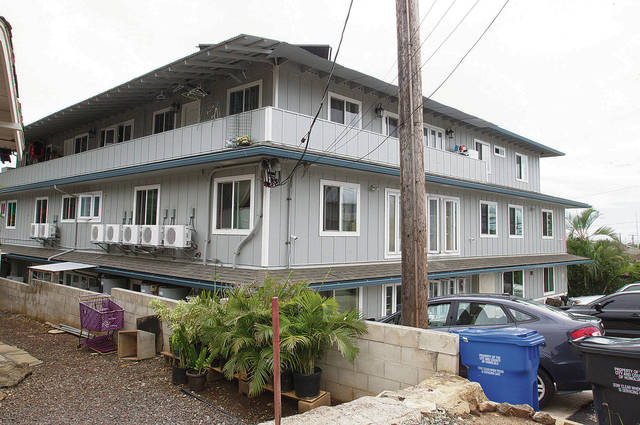Honolulu City Council passes bill to crack down on ‘monster’ homes

CINDY ELLEN RUSSELL / 2017
Critics say outsize homes built in older neighborhoods overburden street parking and infrastructure and are often used as illegal rentals, vacation homes or other nonconforming businesses. Above, this house on Houghtailing Street in Kalihi has 28 bedrooms.
A bill aimed at addressing the issue of monster houses in the long term won final approval from the Honolulu City Council Wednesday.
The vote was 9-0.
Under Bill 79 (2018) Opens in a new tab, the maximum density of a detached dwelling would not be allowed to have a floor area greater than 70% of a lot’s size, or what’s known as a floor area ratio (FAR) of 0.7.
Any house with an FAR greater than 0.6, however, would need to be owner- occupied and be subject to additional rules. Specifically, they would have to have 8-foot side and rear yards and be able to obtain a temporary certificate of occupancy for only up to a year, during which time the Department of Planning and Permitting (DPP) could inspect the house.
The Council has been wrestling for several years with how to curb the proliferation of monster houses that go up quickly, often defy city building rules and dwarf other homes in older residential neighborhoods. Critics say the structures overburden street parking and infrastructure and are often used as illegal rentals, vacation homes or other nonconforming businesses.
The uproar over monster houses also has triggered a backlash from legitimate homebuilders and the Building Industry Association of Hawaii, who worry that new regulations might go too far and create delays in obtaining building permits from DPP — a process they say already takes too long when there’s a huge demand for housing on the island.
Don't miss out on what's happening!
Stay in touch with breaking news, as it happens, conveniently in your email inbox. It's FREE!
Former Councilman Trevor Ozawa introduced Bill 79 (2018) last fall as a comprehensive policy for addressing the phenomenon. Council Zoning Chairwoman Kymberly Pine helped shepherd the bill through her committee. She called the end product a hard-earned compromise between opponents of large-scale houses and the building industry community, noting that an advisory group made up of people with various, sometimes opposing interests worked for several months to come up with a bill.
“The various stakeholders were very far apart on so many things, and even DPP still has some concerns,” Pine said. “But I have to say 95% of the concerns have been negotiated where everybody can live with it. That’s very rare in such a divisive bill.”
Also under the bill that passed:
>> A minimum of two on-site parking stalls are required, plus one stall for each additional 750 square feet over 2,500 square feet (excluding carports and garages).
>> The definition of bathrooms require either a sink, a toilet or both. Additionally, houses up to 5,999 square feet would be allowed up to 4-1/2 bathrooms under a sliding scale, although Pine said she wants to work further on lowering the number allowed for larger homes.
>> Converting or altering a wet bar, laundry room or bathroom are prohibited unless specifically allowed under a valid building permit.
>> A limit of 75% of a property can be covered with an impervious surface, such as concrete or asphalt.
Much of Wednesday’s discussion centered on the issue of impervious surfaces.
Councilwoman Heidi Tsuneyoshi attempted to remove the requirement. She cited concerns raised by Acting DPP Director Kathy Sokugawa, who said she believes the issue is separate from monster houses and requires further study.
But Pine argued that the impervious surface provision was a key component for the bill’s proponents and Tsuneyoshi’s motion was defeated 5-4.
Representatives from HI Good Neighbor, the Outdoor Circle Manoa branch and Malama Manoa erupted in applauses after the bill was approved.
A two-year moratorium on the issuance of building permits for large-scale houses was adopted by Council members in March 2018 while they worked on more permanent legislation.




